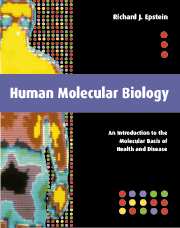Book contents
- Frontmatter
- Contents
- Preface
- Acknowledgements
- Read me first …
- Glossary
- Dedication
- Introduction: A disease for every gene?
- I From molecular biology to human genetics
- 1 Biomolecular evolution
- 2 Chromatin and chromosomes
- 3 Gene expression
- 4 RNA processing and translation
- 5 Protein structure and function
- II From molecular genetics to human biochemistry
- III From molecular biochemistry to human cell biology
- IV From molecular cell biology to human physiology
- V From molecular physiology to human molecular biology
- Index
2 - Chromatin and chromosomes
Published online by Cambridge University Press: 01 June 2011
- Frontmatter
- Contents
- Preface
- Acknowledgements
- Read me first …
- Glossary
- Dedication
- Introduction: A disease for every gene?
- I From molecular biology to human genetics
- 1 Biomolecular evolution
- 2 Chromatin and chromosomes
- 3 Gene expression
- 4 RNA processing and translation
- 5 Protein structure and function
- II From molecular genetics to human biochemistry
- III From molecular biochemistry to human cell biology
- IV From molecular cell biology to human physiology
- V From molecular physiology to human molecular biology
- Index
Summary
The informational capacity of the human genome reflects the extraordinary length and compressibility of the DNA molecule. The size of the genome poses special problems for the mapping and cloning of genes implicated in human disease. Here we consider the higher structure of this long and winding molecule.
Chromatin structure
Genomes are characterized by a multilayer architecture
Your body has grown from a single diploid cell to a biological mass of 5.1013 cells. This is an impressive organizational feat for a parental cell measuring 10 μm in diameter with only ten picograms (10 pg) of DNA in its (haploid) genome of 3·109 bp. How does DNA do it?
Each one of your cells contains 1000-fold more DNA than a bacterium; if stretched, this DNA would measure about two meters. However, cells of certain flowers (e.g., lilies) contain 100-fold more DNA than human cells. Hence, although genomic structural complexity is a prerequisite for biological complexity, no linear relationship between genome size and biological complexity can be assumed. Put another way, a small genome implies a simple (small and short-lived) organism, but a large genome does not necessarily encode a complex (or large, or long-lived) organism.
The fact that the sum total of DNA in your body could stretch to the Moon and back a certain number of times is of more than Sunday-newspaper significance. The key to this statistic is that DNA exists in a highly condensed state within cell nuclei, several thousand-fold more tightly packed than naked DNA.
- Type
- Chapter
- Information
- Human Molecular BiologyAn Introduction to the Molecular Basis of Health and Disease, pp. 49 - 76Publisher: Cambridge University PressPrint publication year: 2002



